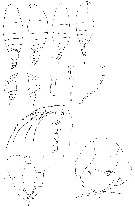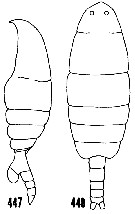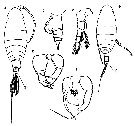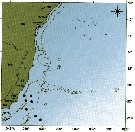|
|
 |
|
Calanoida ( Order ) |
|
|
|
Diaptomoidea ( Superfamily ) |
|
|
|
Fosshageniidae ( Family ) |
|
|
|
Temoropia ( Genus ) |
|
|
| |
Temoropia mayumbaensis T. Scott, 1894 (F,M) | |
| | | | | | | Syn.: | Temeropia mayumbaensis : Marques, 1953 (p.109, fig.F); 1959 (p.214); Björnberg, 1963 (p.48, Rem.); Pavlova, 1966 (p.44); Dias & Araujo, 2006 (p.66, Rem., chart); Ayon & al., 2008 (p.238, Table 4: Peruvian samples); Dias & al., 2010 (p.230, Table 1);
no Temoropia mayumbaensis : Farran, 1908 b (p.59, figs.F, Rem.); Holmes, 2001 (p.29);
No Temoropia mayumbaensis: Wheeler, 1970 (p.12, "slender P5", figs.F) | | | | Ref.: | | | T. Scott, 1894 b (p.79, figs.F,M); Giesbrecht & Schmeil, 1898 (p.96); Thompson & Scott, 1903 (p.234, 248); A. Scott, 1909 (p.119, Rem.); ? Farran, 1929 (p.209, 257, figs.F); Sewell, 1932 (p.246, Rem.); Rose, 1933 a (p.174, figs.F,M); Farran, 1936 a (p.110, figs.F,M, Rem.); C.B. Wilson, 1942 a (p.209, figs.F,M); Grice, 1962 (p.213, figs.F,M); Chen & Zhang, 1965 (p.67, figs.F); Vervoort, 1965 (p.102, Rem.); Owre & Foyo, 1967 (p.69, figs.F,M)); Vilela, 1968 (p.23, fig.F); Corral Estrada, 1970 (p.172); Wheeler, 1970 (part, p.12, "thickened P5", figs.F); Björnberg & al., 1981 (p.640, figs.F,M); Schulz, 1986 (p.141, Rem.); Kim & al., 1993 (p.270); Chihara & Murano, 1997 (p.916, Pl.180: F,M); Bradford-Grieve & al., 1999 (p.884, 954, figs.F,M); Boxshall & Halsey, 2004 (p.122); Vives & Shmeleva, 2007 (p.528, figs.F,M, Rem.); Blanco-Bercial & al., 2011 (p.103, Table 1, Biol. mol, phylogeny) |  issued from: Q.-c Chen & S.-z. Zhang in Studia Marina Sinica, 1965, 7. [Pl.21, 10-12]. Female (from E China Sea): 10, habitus (dorsal); 11, urosome (lateral right side); 12, P5 (posterior).
|
 issued from : J. Corral Estrada in Tesis Doct., Univ. Madrid, A-129, Sec. Biologicas, 1970. [Lam.47, figs.2-4]. Female (from Canarias Is.): 2, habitus (lateral left side); 3, idem (dorsal); 4, P5.
|
 issued from : C.B. Wilson in Scientific Results of Cruise VII of the Carnegie during 1928-1929. Biology-I. Carnegie Inst. Wash. Publ. 536, 1942. [p.231, Figs.116-117]. Female (from Pacific): 117, P5. Male (from Pacific): 116, P5.
|
 Issued from : E.H. Wheeler, Jr in Smiths. Contr. Zool., 1970, 55. [p.27, Figs.67-70]. As Temoropia mayumbeensis with \\\"thicknened \\\" P5. Female (from NW Atlantic): 67, habitus (lateral); 68, P5; 69, rostrum (ventrolateral view); 70, urosome (three-quarter ventral view).
|
 issued from : G.D. Grice in Fish. Bull. Fish and Wildl. Ser., 1962, 61. [p.214, Pl.20, Figs.1-12]. Female (from equatorial Pacific): 1, habitus (dorsal and lateral, respectively); 3-4, posterior part of thorax and urosome (left and right sides, rspectively); 5, Mxp; 6, P5. Male: 7-8, habitus (dorsal and lateral, respectively)9, rostrum; 10, A1; 11, distal two segments of A1; 12, P5.
|
 issued from : H.B. Owre & M. Foyo in Fauna Caribaea, 1, Crustacea, 1: Copepoda. Copepods of the Florida Current. [p.69, Figs.447, 448]. Female: 447, habitus (lateral). Male:448, habitus (dorsal).
|
 issued from : H.B. Owre & M. Foyo in Fauna Caribaea, 1, Crustacea, 1: Copepoda. Copepods of the Florida Current. [p.21, Figs.80, 81]. Female: 80, P5. Male: 81, P5.
|
 Issued from : M. Chihara & M. Murano in An Illustrated Guide to Marine Plankton in Japan, 1997. [p.918, Pl. 180, fig.280 a-f]. Female : a, habitus (dorsal); b, P5; c, urosome (lateral); d, P1. Male: e, habitus (dorsal); f, P5. Note characteristics numbered 1 into circles.
|
 Issued from : V.N. Andronov in Russian Acad. Sci. P.P. Shirshov Inst. Oceanol. Atlantic Branch, Kaliningrad, 2014. [p.84, Fig.21: 5]. Temoropia amyumbaensis after Deevey, 1972. Female P5.
| | | | | Compl. Ref.: | | | Sewell, 1948 (p.418, 428, 440, 502, 546); Heinrich, 1961 (p.87); Grice & Hart, 1962 (p.287, 293: Rem.); V.N. Greze, 1963 a (tabl.2); Grice, 1963 a (p.495); Shmeleva, 1964 a (p.1068); Unterüberbacher, 1964 (p.26); De Decker & Mombeck, 1964 (p.14); Grice & Hulsemann, 1965 (p.224); 1967 (p.17); Furuhashi, 1966 a (p.295, vertical distribution in Oyashio/Kuroshio transitional area, Table 8); Fleminger, 1967 a (tabl.1); Vinogradov, 1968 (1970) (p.79); Delalo, 1968 (p.138); Park, 1970 (p.476); Deevey, 1971 (p.225); Gamulin, 1971 (p.382, tab.3); Bainbridge, 1972 (p.61, Appendix Table I: vertical distribution vs day/night, Table II: %); Binet & al., 1972 (p.69); Heinrich, 1973 (p.95); Corral Estrada & Pereiro Muñoz, 1974 (tab.I); Deevey & Brooks, 1977 (p.256, tab.2, Station "S"); Carter, 1977 (1978) (p.36); Dessier, 1979 (p.201, 206); Kovalev & Shmeleva, 1982 (p.84); Vives, 1982 (p.293); Greze & al., 1983 (p.17); Scotto di Carlo & al., 1984 (p.1043); Greze & al., 1985 (p.7); Almeida Prado Por, 1985 (p.250); Brenning, 1985 (p.5, Rem.: p.13); 1985 a (p.28, Table 2); Brinton & al., 1986 (p.228, Table 1); Madhupratap & Haridas, 1986 (p.105, tab.1); Lozano Soldevilla & al., 1988 (p.59); Scotto di Carlo & al., 1991 (p.270); Shih & Young, 1995 (p.74); Padmavati & Goswami, 1996 a (p.85, fig.3, Table 4, vertical distribution); Hure & Krsinic, 1998 (p.60, 101, 112); Padmavati & al., 1998 (p.349); Suarez-Morales & Gasca, 1998 a (p.111); Madhupratap & al., 2001 (p. 1345, vertical distribution vs. O2, figs.4, 5: clusters, p.1353); Vukanic, 2003 (139, tab.1); Hsiao & al., 2004 (p.326, tab.1); Lo & al., 2004 (p.89, tab.1); Vukanic & Vukanic, 2004 (p.9, tab. 2); Kazmi, 2004 (p.229); Valdés & al., 2007 (p.104: tab.1); Dur & al., 2007 (p.197, Table IV); Cornils & al., 2007 (p.278, Table 2); Morales-Ramirez & Suarez-Morales, 2008 (p.522); Lan Y.-C. & al., 2008 (p.61, Table 1, % vs stations, Table 2: indicator species); C.-Y. Lee & al., 2009 (p.151, Tab.2); Licandro & Icardi, 2009 (p.17, Table 4); Cornils & al., 2010 (p.2076, Table 3 as Temeropia mayumbiensis); Schnack-Schiel & al., 2010 (p.2064, Table 2: E Atlantic subtropical/tropical); Mazzocchi & Di Capua, 2010 (p.428); Medellin-Mora & Navas S., 2010 (p.265, Tab. 2); Andersen N.G. & al., 2011 (p.71, Fig.3: abundance); Hsiao S.H. & al., 2011 (p.475, Appendix I: as Tomoropia, lapsus calami); in CalCOFI regional list (MDO, Nov. 2013; M. Ohman, comm. pers.); Tachibana & al., 2013 (p.545, Table 1, seasonal change 2006-2008); Lidvanov & al., 2013 (p.290, Table 2, % composition); Siokou & al., 2013 (p.1313, fig.4, 8, biomass, vertical distribution); Bonecker & a., 2014 (p.445, Table II: frequency, horizontal & vertical distributions); Belmonte, 2018 (p.273, Table I: Italian zones); Hure M. & al., 2018 (p.1, Table 1: abundance, % composition, Table 2: correlations, Rem.: p.12) | | | | NZ: | 15 | | |
|
Distribution map of Temoropia mayumbaensis by geographical zones
|
| | | | | | | | | | | |  issued from : C. de O. Dias & A.V. Araujo in Atlas Zoopl. reg. central da Zona Econ. exclus. brasileira, S.L. Costa Bonecker (Edit), 2006, Série Livros 21. [p.31]. As Temeropia mayumnbaensis. issued from : C. de O. Dias & A.V. Araujo in Atlas Zoopl. reg. central da Zona Econ. exclus. brasileira, S.L. Costa Bonecker (Edit), 2006, Série Livros 21. [p.31]. As Temeropia mayumnbaensis.
Chart of occurrence in Brazilian waters (sampling between 22°-23° S).
Nota: sampling 14 specimens. |
| | | | Loc: | | | South Africa (E), Namibia, Angola, Congo, G. of Guinea, Brazil (off Rio de Janeiro, Vitoria-Cabo de Sao Tomé, off Macaé), Ivorian shelf, off Amazon, off Morocco-Mauritania, Canary Is., Portugal, NW Spain, Ibero-moroccan Bay, Barbados Is., Caribbean Sea, Caribbean Colombia, G. of Mexico, Florida, Sargasso Sea, off Bermuda: Station ‘’ S’’ (32°10’N, 64°30’W), Medit. (Alboran Sea, W Basin, Ligurian Sea, Tyrrhenian Sea, S Adriatic Sea, Ionian Sea, Aegean Sea, Johnston Bank, Lebanon Basin), G. of Suez, G. of Aqaba, Red Sea, Arabian Sea, W India (Goa - Gujarat), Natal, Indian, Indonesia-Malaysia, SW Celebes, China Seas (East China Sea), Taiwan (SW, E, N: Mienhua Canyon, NW), S Korea, Japan (Tokyo Bay, S Bösö); off SE Japan, Australia (Great Barrier), New Zealand, Pacif. (W equatorial), California, Gulf of California, W Costa Rica, Peru | | | | N: | 102 | | | | Lg.: | | | (5) F: 0,94; M: 0,9; (16) F: 1,045-0,99; (34) F: 0,92-0,7; M: 0,84; (35) F: 0,78; (57) F: 0,93; M: 0,93; (54) F: 1,17-1; M: 0,99-0,96; (75) F: 1,11-0,93; M: 0,98-0,86; (101) F: 0,99-0,94; M: 0,92-0,88; (180) F: 0,87; (203) F: 0,56; 0,75; 0,79; 0,86; (237) F: 1,0; M: 0,9; (327) F: 0,86; (432) F: 1,15; (1308) F: 1,06; M: 0,9-1,06; {F: 0,56-1,17; M: 0,84-1,06} | | | | Rem.: | Offshore. Epipelagic (occasionally)- Meso-bathypelagic. Sargasso Sea: 0-1000 m (Deevey & Brooks, 1977, Station "S");
After Björnberg (1963, p.48) this species is registered for the first time in Brazilian waters. heinrich (1961) found the species in large numbers in the North West Subtropical Pacific, concentrated in the 50-100 m deep layer or near the surface during the day; at night it reached 500 m depth.
For Vervoort (1965, p.102) the species shows few morphological variations. Wheeler (1970, p.12) observes two types of P5 on the females: "slender" and "thickened". Accompanying the thickened feature of the legs is the presence of a spinelike process on the genital segment of the adult; individuals with "slender P5" do not show this spine. Examination of additional individuals may provide a basis for eventually separating these two types. The first type corresponds to this species, the second to Temoropia minor. A doubt exists on the identification of T. mayumbaensis by Farran (1929) which could be Temoropia minor.
Owre & Foyo (1967, p.69) point to the species at the depths from 110 to 1000 m. | | | Last update : 27/10/2020 | |
|
|
 Any use of this site for a publication will be mentioned with the following reference : Any use of this site for a publication will be mentioned with the following reference :
Razouls C., Desreumaux N., Kouwenberg J. and de Bovée F., 2005-2025. - Biodiversity of Marine Planktonic Copepods (morphology, geographical distribution and biological data). Sorbonne University, CNRS. Available at http://copepodes.obs-banyuls.fr/en [Accessed January 01, 2026] © copyright 2005-2025 Sorbonne University, CNRS
|
|
 |
 |













